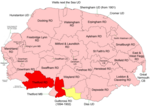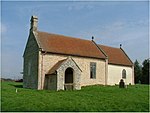Ickburgh

Ickburgh is a village and civil parish in the English county of Norfolk. It is situated on the A1065 Mildenhall to Fakenham road, some 5.5 miles (8.9 km) north of Brandon and 9 miles (14 km) south of Swaffham. The village is 36 miles (58 km) from the city of Norwich and 89 miles (143 km) from London. The population (including Cranwich) and Didlington was 309 in 134 households at the 2011 Census. The parish has an area of 1,221 hectares (3,020 acres) and in the 2001 census had a population of 245 in 99 households. The parish shares boundaries with the adjacent parishes of Hilborough, Foulden, Didlington, Mundford, Lynford and Stanford. The parish falls within the district of Breckland. Local government responsibilities are shared between the parish, district and county councils.The villages name means 'Ic(c)a's fortification'.
Excerpt from the Wikipedia article Ickburgh (License: CC BY-SA 3.0, Authors, Images).Ickburgh
Ashburton Road, Breckland District
Geographical coordinates (GPS) Address Nearby Places Show on map
Geographical coordinates (GPS)
| Latitude | Longitude |
|---|---|
| N 52.52162 ° | E 0.66638 ° |
Address
Ashburton Road
Ashburton Road
IP26 5JA Breckland District
England, United Kingdom
Open on Google Maps










